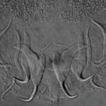
Myotoxin-3 from the Pacific Rattlesnake Crotalus oreganus oreganus Venom Is a New Microtubule-Targeting Agent
Sign Up to like & getrecommendations! Published in 2022 at "Molecules"
DOI: 10.3390/molecules27238241
Abstract: Microtubule targeting agents (MTA) are anti-cancer molecules that bind tubulin and interfere with the microtubule functions, eventually leading to cell death. In the present study, we used an in vitro microtubule polymerization assay to screen… read more here.
Keywords: microtubule targeting; rattlesnake crotalus; pacific rattlesnake; microtubule ... See more keywords

Neotropical Rattlesnake (Crotalus simus) Venom Pharmacokinetics in Lymph and Blood Using an Ovine Model
Sign Up to like & getrecommendations! Published in 2020 at "Toxins"
DOI: 10.3390/toxins12070455
Abstract: The most abundant protein families in viper venoms are Snake Venom Metalloproteases (SVMPs), Snake Venom Serine Proteases (SVSPs) and Phospholipases (PLA2s). These are primarily responsible for the pathophysiology caused by the bite of pit-vipers; however,… read more here.
Keywords: venom; crotalus simus; lymph blood; blood ... See more keywords

Biological and Medical Aspects Related to South American Rattlesnake Crotalus durissus (Linnaeus, 1758): A View from Colombia
Sign Up to like & getrecommendations! Published in 2022 at "Toxins"
DOI: 10.3390/toxins14120875
Abstract: In Colombia, South America, there is a subspecies of the South American rattlesnake Crotalus durissus, C. d. cumanensis, a snake of the Viperidae family, whose presence has been reduced due to the destruction of its… read more here.
Keywords: biological medical; rattlesnake crotalus; south american; crotalus durissus ... See more keywords

Parasites in feces of the endemic rattlesnake, Crotalus triseriatus (Serpentes: Viperidae), from Mexican highlands
Sign Up to like & getrecommendations! Published in 2019 at "Zoologia"
DOI: 10.3897/zoologia.36.e29587
Abstract: There are few studies about parasitic infections in Crotalus triseriatus (Wagler, 1830), an endemic rattlesnake from the highlands of central Mexico. This species occupies several habitats, from conserved forested regions to heavily impacted landscapes. To… read more here.
Keywords: parasites feces; endemic rattlesnake; feces endemic; crotalus triseriatus ... See more keywords